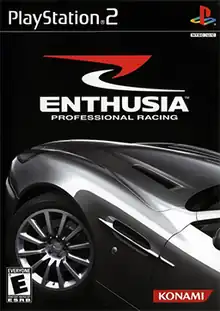Enthusia Professional Racing
Enthusia Professional Racing (エンスージアプロフェッショナルレーシング, Ensūjia Purofesshonaru Rēshingu) is a racing game for the PlayStation 2. It is the first sim racing game made by Konami.
| Enthusia Professional Racing | |
|---|---|
 | |
| Developer(s) | Konami |
| Publisher(s) | Konami |
| Designer(s) | Manabu Akita |
| Composer(s) | Masanori Akita Yuichi Tsuchiya HAL |
| Platform(s) | PlayStation 2 |
| Release | |
| Genre(s) | Sim racing |
| Mode(s) | Single player Multiplayer |
Gameplay
Enthusia Professional Racing has five available play modes:[1]
- Enthusia Life (career mode)
- Driving Revolution
- Free Race
- Time Attack
- Versus Racing
Enthusia Life
As opposed to purchasing vehicles as in the majority of games in the sim racing genre, cars are unlocked by a roulette-style method after completing a race, which determines which opposing car in the race the player unlocks (although in this roulette, "no car" is also one of the possibilities).
Instead of purchasing parts to improve cars, a points-based system is use to determine upgrades.[2] When enough of these "Enthu Points" (otherwise known as "Driver HP" in Japan) are obtained, a stat of the car (weight, power, or tires) is upgraded, up to three times each. The game also uses these points to keep track of collisions with walls and cars, or going off course - reducing your overall point count in each case. The more points are lost, the less points one gets to upgrade a car.
The driver can also be upgraded in the same way, with the points changing stats such as maximum number of Driver HP or the rate at which they are recovered after a race. If a player runs out of points during a race, the player has to miss the next race. Full HP can be restored by "resting", and a large amount is restored when changing a car.
Driving Revolution
In this mode players must attempt to pass through gates at the correct speed while accelerating, braking or keeping a constant speed. Points are gained for doing this correctly and enough points must be gained to pass on to the next level.
Features
Promotional material for the game emphasised the accuracy of the game's physics.[3] To demonstrate the accuracy, a video was produced which shows a direct comparison between a Mazda MX5 being driven in Enthusia and its real life counterpart on the same course. It is among the demos that play when the game is left idle on the title screen.[4]
The game's visual effects include a G meter termed "FGS" (which includes a representation of the car's tyres and their grip), a translucent "moving window" g-force effect and a speed blur effect in first person view.
The game's highly detailed car models include additional animated parts for specific cars, such as the retracting spoiler of the Bugatti EB110.
Featured race tracks (of which all but 2 - Tsukuba and Nürburgring Nordschleife - are fictional) include realistic foreground textures, and feature animations such as birds taking off, spinning wind turbines, flowing waterfalls, rivers and fountains, moving car traffic, sand being blown over dunes, and even a full aerobatic demonstration team emitting coloured smoke trails.
Enthusia accurately represents automatic transmissions, taking advantage of the Dualshock 2's pressure-sensitive throttle input to mimic real automatic transmission characteristics.
Enthusia can be used with the Logitech Driving Force, Driving Force Pro, Driving Force GT and G25 steering wheels.
Reception
| Aggregator | Score |
|---|---|
| Metacritic | 70/100[5] |
| Publication | Score |
|---|---|
| Edge | 5/10[6] |
| Electronic Gaming Monthly | 8.33/10[7] |
| Eurogamer | 6/10[8] |
| Famitsu | 29/40[9] |
| Game Informer | 8/10[10] |
| GamePro | |
| GameRevolution | C[12] |
| GameSpot | 7.4/10[13] |
| GameSpy | |
| GameZone | 6.9/10[15] |
| IGN | 7.2/10[16] |
| Official U.S. PlayStation Magazine | |
| Detroit Free Press |
The game received "average" reviews according to the review aggregation website Metacritic.[5] In Japan, Famitsu gave it a score of one eight and three sevens for a total of 29 out of 40.[9]
References
- Enthusia Professional Racing (Game Manual) (PDF). Konami. 2005. p. 6.
- "Enthusia Professional Racing Review". GameSpot. Retrieved 2023-02-04.
- egm magazine (2021-06-24). Electronic Gaming Monthly Issue 192 ( June 2005).
- Enthusia Professional Racing - Remastered Physics Featurette - PS2, retrieved 2023-02-04
- "Enthusia Professional Racing Critic Reviews for PlayStation 2". Metacritic. Retrieved September 21, 2012.
- Edge staff (May 2005). "Enthusia Professional Racing". Edge. No. 149. p. 85.
- EGM staff (June 2005). "Enthusia Professional Racing". Electronic Gaming Monthly. No. 192. p. 100.
- Kristan Reed (May 5, 2005). "Enthusia Professional Racing". Eurogamer. Retrieved May 13, 2017.
- "Enthusia Professional Racing (エンスージアプロフェッショナルレーシング)". Famitsu. Vol. 849. March 25, 2005.
- "Enthusia Professional Racing". Game Informer. No. 146. June 2005. p. 129.
- Funky Zealot (May 3, 2005). "Enthusia Professional Racing Review for PS2 on GamePro.com". GamePro. Archived from the original on May 7, 2005. Retrieved May 13, 2017.
- Brian Gee (June 3, 2005). "Enthusia Professional Racing Review". Game Revolution. Retrieved May 13, 2017.
- Brian Ekberg (May 3, 2005). "Enthusia Professional Racing Review". GameSpot. Retrieved May 13, 2017.
- Justin Leeper (May 4, 2005). "GameSpy: Enthusia Professional Racing". GameSpy. Retrieved May 13, 2017.
- Louis Bedigian (May 8, 2005). "Enthusia Professional Racing - PS2 - Review". GameZone. Archived from the original on December 30, 2008. Retrieved May 13, 2017.
- Ed Lewis (April 28, 2005). "Enthusia Professional Racing". IGN. Retrieved May 13, 2017.
- "Enthusia Professional Racing". Official U.S. PlayStation Magazine. June 2005.
- Al Toby (June 19, 2005). "Enthusia: Professional Racing". Detroit Free Press. Archived from the original on September 17, 2005. Retrieved May 13, 2017.
External links
- Official website at the Wayback Machine (archived May 5, 2009)
- Enthusia Professional Racing at MobyGames